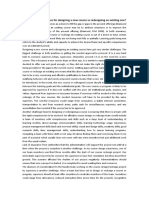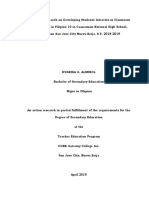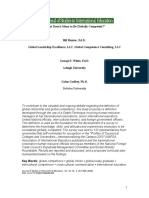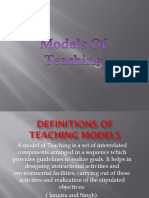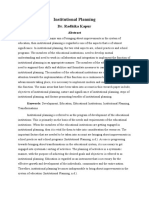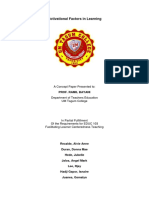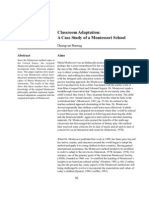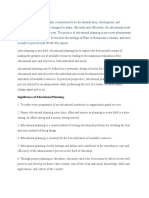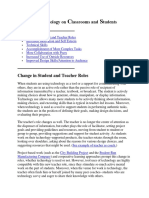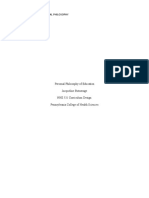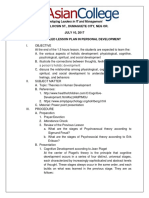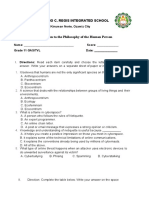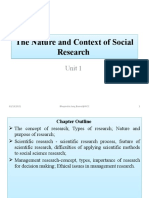How Technology Has Changed Education
How Technology Has Changed Education
Uploaded by
Goh Goit ChooCopyright:
Available Formats
How Technology Has Changed Education
How Technology Has Changed Education
Uploaded by
Goh Goit ChooOriginal Description:
Copyright
Available Formats
Share this document
Did you find this document useful?
Is this content inappropriate?
Copyright:
Available Formats
How Technology Has Changed Education
How Technology Has Changed Education
Uploaded by
Goh Goit ChooCopyright:
Available Formats
How Technology Has Changed Education?
When students are using technology as a tool or a support for communicating with others, they are in an active role rather than the passive role of recipient of information transmitted by a teacher, textbook, or broadcast. The student is actively making choices about how to generate, obtain, manipulate, or display information. Technology use allows many more students to be actively thinking about information, making choices, and executing skills than is typical in teacher-led lessons. Moreover, when technology is used as a tool to support students in performing authentic tasks, the students are in the position of defining their goals, making design decisions, and evaluating their progress. The teacher's role changes as well. The teacher is no longer the center of attention as the dispenser of information, but rather plays the role of facilitator, setting project goals and providing guidelines and resources, moving from student to student or group to group, providing suggestions and support for student activity. As students work on their technology-supported products, the teacher rotates through the room, looking over shoulders, asking about the reasons for various design choices, and suggesting resources that might be used. The most common teacher-reported effect on students was an increase in motivation. Teachers and students are sometimes surprised at the level of technology-based accomplishment displayed by students who have shown much less initiative or facility with more conventional academic tasks. Teachers talked about motivation from a number of different perspectives. Some mentioned motivation with respect to working in a specific subject area, for example, a greater willingness to write or to work on computational skills. In many of these classes, students choose to work on their technology-based projects during recess or lunch periods. Teachers also frequently cite technology's motivational advantages in providing a venue in which a wider range of students can excel. Compared to conventional classrooms with their stress on verbal knowledge and multiple-choice test performance, technology provides a very different set of challenges and different ways in which students can demonstrate what they understand. A related technology effect stressed by many teachers was enhancement of student self esteem. Both the increased competence they feel after mastering technology-based tasks and their awareness of the value placed upon technology within our culture, led to increases in students' sense of self worth.
Another effect of technology cited by a great majority of teachers is an increased inclination on the part of students to work cooperatively and to provide peer tutoring. While many of the classrooms we observed assigned technology-based projects to small groups of students, as discussed above, there was also considerable tutoring going on around the use of technology itself. Collaboration is fostered for obvious reasons when students are assigned to work in pairs or small groups for work at a limited number of computers. But even when each student has a computer, teachers note an increased frequency of students helping each other. Technology-based tasks involve many subtasks, leading to situations where students need help and find their neighbour a convenient source of assistance. Students who have mastered specific computer skills generally derive pride and enjoyment from helping others. In addition, the public display and greater legibility of student work creates an invitation to comment. Students often look over each others' shoulders, commenting on each others' work, offering assistance, and discussing what they are doing. Experiences in developing the kinds of rich, multimedia products that can be produced with technology, particularly when the design is done collaboratively so that students experience their peers' reactions to their presentations, appear to support a greater awareness of audience needs and perspectives. Multiple media give students choices about how best to convey a given idea. In part because they have the capability to produce more professional-looking products and the tools to manipulate the way information is presented, students in many technology-using classes are reportedly spending more time on design and audience presentation issues. Students, even at the elementary school level, are able to acquire an impressive level of skill with a broad range of computer software. Although the specific software tools in use will likely change before these students enter the world of work, the students acquire a basic understanding of how various classes of computer tools behave and a confidence about being able to learn to use new tools that will support their learning of new software applications. Teachers for the observed classes and activities at the case study sites were nearly unanimous also in reporting that students were able to handle more complex assignments and do more with higher-order skills because of the supports and capabilities provided by technology.
You might also like
- The Importance of Training and Development in Employee Performance and EvaluationDocument8 pagesThe Importance of Training and Development in Employee Performance and EvaluationMUHAMMAD AMMAD ARSHAD0% (1)
- Challenges For Designing A New Course Vs Redesigning An Existing OneDocument2 pagesChallenges For Designing A New Course Vs Redesigning An Existing Onemisheck banda100% (3)
- Reflective EssayDocument3 pagesReflective Essayapi-261601610No ratings yet
- System TheoryDocument5 pagesSystem TheoryShakil AhmadNo ratings yet
- Sarah Lesson Plan 2Document2 pagesSarah Lesson Plan 2api-260894328No ratings yet
- Quantitative Techniques For Managerial DecisionsDocument3 pagesQuantitative Techniques For Managerial DecisionsBijita BiswasNo ratings yet
- An Action Research On Developing Students Interests in Classroom Participation in Filipino 10 in Caanawaan National High SchoolDocument18 pagesAn Action Research On Developing Students Interests in Classroom Participation in Filipino 10 in Caanawaan National High Schoolivy mae flores100% (8)
- William Blake and Jacob Boehme: Imagination, Experience and The Limitations of Reason PDFDocument23 pagesWilliam Blake and Jacob Boehme: Imagination, Experience and The Limitations of Reason PDFKevin Fischer100% (5)
- TTL 1 L3 ModuleDocument6 pagesTTL 1 L3 ModuleAllyssa JhaneNo ratings yet
- Example Formal Report Methods For Motivating EmployeesDocument15 pagesExample Formal Report Methods For Motivating EmployeesnrljnnhNo ratings yet
- Field Study 1: University of Caloocan CityDocument7 pagesField Study 1: University of Caloocan CityLovelyn MaristelaNo ratings yet
- Unit 1: Developing A Business PlanDocument15 pagesUnit 1: Developing A Business PlanChe NelynNo ratings yet
- Behavioral ObjectivesDocument4 pagesBehavioral ObjectivesDilruk GallageNo ratings yet
- First Principles of Instruction: Marriner David MerillDocument2 pagesFirst Principles of Instruction: Marriner David MerillStan VejarNo ratings yet
- Failure of Business EnterprisesDocument10 pagesFailure of Business EnterprisesManish RajkoomarNo ratings yet
- CURRICULUM CONTENT InformationDocument14 pagesCURRICULUM CONTENT Informationmithun d'souzaNo ratings yet
- Contextualized Learning: Teaching Made Highly Effective!: ElearningDocument4 pagesContextualized Learning: Teaching Made Highly Effective!: ElearningXianPaulette Mingi ManalaysayNo ratings yet
- The Role of Art TeachersDocument8 pagesThe Role of Art TeacherssundualvinNo ratings yet
- Employee Motivation Project ReportDocument62 pagesEmployee Motivation Project ReportVaishali SalunkeNo ratings yet
- Global CompetencesDocument28 pagesGlobal CompetencesIoana Eftimie100% (1)
- Massive Open Online Course (MOOC)Document7 pagesMassive Open Online Course (MOOC)Miko GarciaNo ratings yet
- Behaviorism, Cognitivism, ConstructivismDocument14 pagesBehaviorism, Cognitivism, ConstructivismJayson SorianoNo ratings yet
- Overview of Management Theories and PracticesDocument49 pagesOverview of Management Theories and PracticesBabajide AdedapoNo ratings yet
- Assignment LINDocument4 pagesAssignment LINMeimon Sanai100% (1)
- Meaning of StaffingDocument3 pagesMeaning of StaffingBernadette LlanetaNo ratings yet
- Swot AnalysisDocument211 pagesSwot AnalysisSakali AliNo ratings yet
- Bonuses Can BackfireDocument2 pagesBonuses Can Backfireyoshit bonam100% (1)
- Leadership and ManagementDocument61 pagesLeadership and ManagementObaidNo ratings yet
- ARCS Model of Motivational DesignDocument2 pagesARCS Model of Motivational DesignTang Lih FangNo ratings yet
- Instructional PlanningDocument30 pagesInstructional PlanningTyrone O. GilNo ratings yet
- Models of TeachingDocument25 pagesModels of TeachingRavi Shankar Rajput100% (1)
- Definition of Instructional SupervisionDocument1 pageDefinition of Instructional SupervisionMuriel Comeros100% (1)
- Virtual LearningDocument9 pagesVirtual Learningrmm04150% (1)
- Educ 5220 U3 DaDocument1 pageEduc 5220 U3 DaJunaid KhanNo ratings yet
- InstitutionalPlanning Paper6Document13 pagesInstitutionalPlanning Paper6Thousiff SheriffNo ratings yet
- Computer As A ToolDocument5 pagesComputer As A Toolapi-266097344No ratings yet
- What Is Standardized TestingDocument5 pagesWhat Is Standardized TestingLe Di ChangNo ratings yet
- Managerial Economics and Gap Between Theory and PracticeDocument6 pagesManagerial Economics and Gap Between Theory and Practicesamuel debebeNo ratings yet
- Infographic Lesson Plan TemplateDocument5 pagesInfographic Lesson Plan Templateapi-649726206No ratings yet
- RRL On Educational PlanningDocument13 pagesRRL On Educational Planningalican karimNo ratings yet
- Educ103 Motivational Factors in LearningDocument10 pagesEduc103 Motivational Factors in LearningChristine Malasaga QuintanaNo ratings yet
- Types of Educational-TechnologyDocument4 pagesTypes of Educational-TechnologyVaishnavi Kamalakannan100% (1)
- Final Exam: Bio-Psychological Foundation of EducationDocument8 pagesFinal Exam: Bio-Psychological Foundation of EducationRoselle LagamayoNo ratings yet
- Curriculum Development Module 8Document3 pagesCurriculum Development Module 8Jane Ariane TilloNo ratings yet
- Survey QuestionnaireDocument2 pagesSurvey QuestionnaireDONALYN SARMIENTO0% (1)
- Theory of X and YDocument3 pagesTheory of X and YMildred VillarubiaNo ratings yet
- Motivation and Study Habits of Working Adults - A Case Study of Masters Students in Open University MalaysiaDocument8 pagesMotivation and Study Habits of Working Adults - A Case Study of Masters Students in Open University Malaysiamandeepsingh6432No ratings yet
- Montessori Class - Case StudyDocument10 pagesMontessori Class - Case StudyMinh HuynhNo ratings yet
- 77 Ways To Motivate Your WorkersDocument5 pages77 Ways To Motivate Your WorkersChaouch NajehNo ratings yet
- Week 1 - ULO B - in A NutshellDocument5 pagesWeek 1 - ULO B - in A NutshellPRINCESS JEAN DELOS REYESNo ratings yet
- Judgmental DataDocument2 pagesJudgmental DataJ BrazilNo ratings yet
- Significance of Educational PlanningDocument6 pagesSignificance of Educational PlanningMuhammad ibrarNo ratings yet
- Online Assignment-Education in The 21st CenturyDocument2 pagesOnline Assignment-Education in The 21st CenturySumithra KrishnanNo ratings yet
- Grades in Quality SchoolDocument40 pagesGrades in Quality SchoolBatool Khan50% (2)
- The Scope of Curriculum ReportDocument4 pagesThe Scope of Curriculum ReportDarlene OrbetaNo ratings yet
- Goals Reflection EssayDocument4 pagesGoals Reflection Essayapi-246277065No ratings yet
- Midterm ExamDocument8 pagesMidterm Examanalisayap01No ratings yet
- PDFDocument16 pagesPDFAnil KhadkaNo ratings yet
- Components of Daily Lesson PlansDocument1 pageComponents of Daily Lesson Plansapi-357377076No ratings yet
- Edgar Dale (Cone of Experience) - Group 1Document18 pagesEdgar Dale (Cone of Experience) - Group 1Darth SidiosNo ratings yet
- Change Management in TVET Colleges: Lessons Learnt from the Field of PracticeFrom EverandChange Management in TVET Colleges: Lessons Learnt from the Field of PracticeNo ratings yet
- Chosen TopicDocument3 pagesChosen Topicapi-341579528No ratings yet
- TanginaDocument25 pagesTanginaJasmin CobillaNo ratings yet
- Bibliography EnglishDocument1 pageBibliography EnglishGoh Goit ChooNo ratings yet
- Literasi (Marking Scheme)Document5 pagesLiterasi (Marking Scheme)Goh Goit ChooNo ratings yet
- Hard QuestionDocument183 pagesHard QuestionWidodo Muis100% (1)
- Crime and PreventionDocument3 pagesCrime and PreventionGoh Goit ChooNo ratings yet
- Kinder - Belief Systems TodayDocument22 pagesKinder - Belief Systems TodayJoel CruzNo ratings yet
- Final Ver2 1 EDITEDDocument23 pagesFinal Ver2 1 EDITEDTrang TrangNo ratings yet
- VaguenessDocument5 pagesVaguenessAuthor SoredaNo ratings yet
- Nhe 531 Personal Philosophy of EducationDocument6 pagesNhe 531 Personal Philosophy of Educationapi-519861494No ratings yet
- Academic Stress Research RevisedDocument8 pagesAcademic Stress Research RevisedOoga BoogaNo ratings yet
- Narrative ResearchDocument9 pagesNarrative ResearchFil LuayonNo ratings yet
- Notes Theodicy 2023Document16 pagesNotes Theodicy 2023Adrián KromkaNo ratings yet
- Gomez Vs Gomez Digest (G.R. No. 156284)Document2 pagesGomez Vs Gomez Digest (G.R. No. 156284)Carlo BorromeoNo ratings yet
- Process SKills Full PaperDocument134 pagesProcess SKills Full PaperNhelia Santos BañagaNo ratings yet
- Acculturation Model - Tanzil PDFDocument11 pagesAcculturation Model - Tanzil PDFtanzil chowdhury100% (1)
- Shortcomings of The Current Approaches in TH Pre-Service and In-Service Chemistry Teachers TrainingsDocument5 pagesShortcomings of The Current Approaches in TH Pre-Service and In-Service Chemistry Teachers TrainingsZelalemNo ratings yet
- How Artificial Intelligence Can Change The World?: Thinking Humanly Thinking Rationally Acting Humanly Acting RationallyDocument2 pagesHow Artificial Intelligence Can Change The World?: Thinking Humanly Thinking Rationally Acting Humanly Acting RationallyAaroohi DudejaNo ratings yet
- Topic 7 Lecture 13 The Role of Counselor As FacilitatorDocument5 pagesTopic 7 Lecture 13 The Role of Counselor As FacilitatorMohamad Shahirraz RusliNo ratings yet
- Edac Assessment 2 Emily Richards s00134486Document12 pagesEdac Assessment 2 Emily Richards s00134486api-286261854No ratings yet
- Lesson Plan in Personal Development July 10Document5 pagesLesson Plan in Personal Development July 10Sevee JLoveNo ratings yet
- ERG Theory of Motivation Clayton PDocument3 pagesERG Theory of Motivation Clayton PAndy TthNo ratings yet
- CurdevDocument13 pagesCurdevBraiden ZachNo ratings yet
- Arcelino C. Regis Integrated School: Kinuman Norte, Ozamiz CityDocument9 pagesArcelino C. Regis Integrated School: Kinuman Norte, Ozamiz CityArnel LomocsoNo ratings yet
- Second WeekDocument7 pagesSecond WeekMary Cherill Punzalan-UmaliNo ratings yet
- Report Card Rubric Grade 5Document4 pagesReport Card Rubric Grade 5stuart5271% (14)
- Training MethodsDocument36 pagesTraining MethodsKhushbu Bavishi50% (2)
- Why Use Songs in ELTDocument2 pagesWhy Use Songs in ELTaplatanskaNo ratings yet
- Research ProposalDocument2 pagesResearch Proposalkingjohn345No ratings yet
- Jadual Sem 1 Upsi MasterDocument3 pagesJadual Sem 1 Upsi MasterEugene Lominus Es'ElNo ratings yet
- Action Research Report (English Team)Document6 pagesAction Research Report (English Team)Phirun TepNo ratings yet
- ProbinsyanoDocument4 pagesProbinsyanoBlue PedrajetaNo ratings yet
- Unit 1 The Nature and Context of Social ResearchDocument48 pagesUnit 1 The Nature and Context of Social ResearchSandeep PanditNo ratings yet

